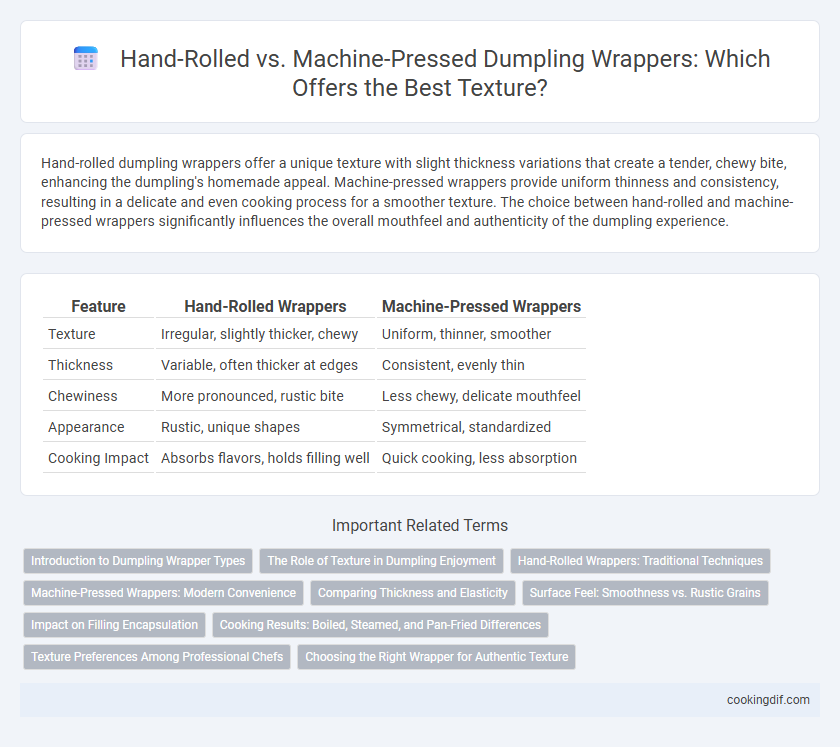Hand-rolled dumpling wrappers offer a unique texture with slight thickness variations that create a tender, chewy bite, enhancing the dumpling's homemade appeal. Machine-pressed wrappers provide uniform thinness and consistency, resulting in a delicate and even cooking process for a smoother texture. The choice between hand-rolled and machine-pressed wrappers significantly influences the overall mouthfeel and authenticity of the dumpling experience.
Table of Comparison
| Feature | Hand-Rolled Wrappers | Machine-Pressed Wrappers |
|---|---|---|
| Texture | Irregular, slightly thicker, chewy | Uniform, thinner, smoother |
| Thickness | Variable, often thicker at edges | Consistent, evenly thin |
| Chewiness | More pronounced, rustic bite | Less chewy, delicate mouthfeel |
| Appearance | Rustic, unique shapes | Symmetrical, standardized |
| Cooking Impact | Absorbs flavors, holds filling well | Quick cooking, less absorption |
Introduction to Dumpling Wrapper Types
Hand-rolled dumpling wrappers offer a unique, chewy texture due to their uneven thickness and artisanal craftsmanship, enhancing the overall eating experience. Machine-pressed wrappers provide a consistent, thin, and smooth texture, ideal for uniform cooking and mass production. Choosing between hand-rolled and machine-pressed wrappers influences the dumpling's bite and filling-to-wrapper ratio, impacting flavor balance and mouthfeel.
The Role of Texture in Dumpling Enjoyment
Hand-rolled wrappers offer a thicker, more elastic texture that creates a chewy bite and enhances the dumpling's overall mouthfeel, while machine-pressed wrappers are typically thinner and more uniform, resulting in a delicate, tender skin. The texture contrast influences the dumpling's ability to hold fillings and absorb cooking liquids, affecting flavor distribution and satisfaction. Optimal texture balance maximizes the sensory appeal and elevates the traditional dumpling experience.
Hand-Rolled Wrappers: Traditional Techniques
Hand-rolled dumpling wrappers offer a unique, slightly uneven texture that enhances the overall mouthfeel, providing a soft yet chewy bite unattainable by machine-pressed alternatives. Traditional techniques involve skillful dough stretching and thinning by hand, resulting in delicate edges and a thicker center that holds fillings better. This artisanal process preserves the authentic taste and texture valued in classic Asian cuisine, making each dumpling a handcrafted culinary experience.
Machine-Pressed Wrappers: Modern Convenience
Machine-pressed dumpling wrappers offer uniform thickness and consistent texture, enhancing the cooking process and ensuring even filling distribution. This modern convenience speeds up production without compromising the chewy elasticity crucial to authentic dumplings. Many commercial kitchens prefer machine-pressed wrappers for their efficiency and reliability in maintaining quality standards.
Comparing Thickness and Elasticity
Hand-rolled dumpling wrappers tend to have variable thickness and greater elasticity, allowing for a chewier texture that enhances the overall eating experience. Machine-pressed wrappers offer consistent thickness but often lack the subtle elasticity found in hand-rolled dough, resulting in a slightly firmer bite. Thickness and elasticity differences significantly impact the dumpling's texture, with hand-rolled wrappers providing a more artisanal and tender mouthfeel.
Surface Feel: Smoothness vs. Rustic Grains
Hand-rolled dumpling wrappers exhibit a rustic grain texture that provides a chewy, artisanal surface feel, enhancing grip and sauce retention. Machine-pressed wrappers offer a consistently smooth and uniform finish, delivering a delicate bite that evenly absorbs flavors. The choice between hand-rolled and machine-pressed directly impacts the dumpling's mouthfeel and textural appeal.
Impact on Filling Encapsulation
Hand-rolled dumpling wrappers create uneven thickness that enhances texture variety and improves filling encapsulation by sealing edges more securely. Machine-pressed wrappers offer uniform thinness, which can reduce the ability to fully enclose juicy fillings, occasionally leading to leakage during cooking. The textural difference impacts how well fillings are retained, affecting overall taste and mouthfeel.
Cooking Results: Boiled, Steamed, and Pan-Fried Differences
Hand-rolled dumpling wrappers offer a chewier texture and slight thickness variation, enhancing absorbency during boiling and steaming, which results in a more tender, flavorful bite. Machine-pressed wrappers are uniformly thin and smooth, providing a crispier edge when pan-fried and consistent cooking times for large batches. Boiled dumplings with hand-rolled wrappers tend to hold fillings better without breaking, while steamed and pan-fried dumplings benefit from the even heat distribution of machine-pressed wrappers for optimal texture.
Texture Preferences Among Professional Chefs
Professional chefs often favor hand-rolled dumpling wrappers for their unique, irregular texture that provides a chewier bite and better sauce absorption compared to machine-pressed wrappers. Hand-rolled wrappers exhibit varying thickness, contributing to a complex mouthfeel that enhances the overall eating experience. Machine-pressed wrappers offer uniform thinness and consistency but can lack the artisanal texture preferred in high-end culinary applications.
Choosing the Right Wrapper for Authentic Texture
Hand-rolled dumpling wrappers offer a thicker, chewier texture with subtle irregularities that enhance the eating experience, reflecting traditional craftsmanship. Machine-pressed wrappers provide uniform thinness, ensuring consistent cooking and a delicate bite, ideal for dumplings requiring a lighter wrapper. Selecting the right wrapper depends on desired texture: hand-rolled for authenticity and chewiness, machine-pressed for even cooking and culinary precision.
Hand-rolled wrappers vs machine-pressed wrappers for texture Infographic

 cookingdif.com
cookingdif.com